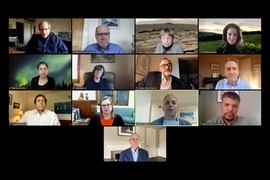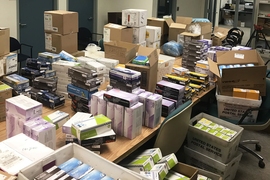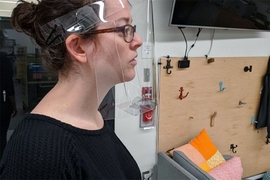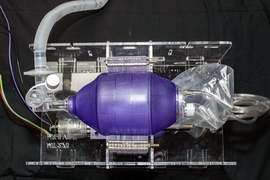As the MIT community adjusts to this unique period of separation and disruption, the Institute’s top leaders held an online “town hall” on Tuesday to answer some of the most frequent questions being asked by students, faculty, and staff. Roughly 7,000 members of the MIT community tuned in live for an update on adjustments and activities underway now, and on planning for the coming summer and fall, given the uncertainties as to how the Covid-19 pandemic may unfold.
“These past few weeks have demonstrated that we are all incredibly interdependent,” said MIT President L. Rafael Reif. “We need each other, yet we do not always know what’s happening in other parts of MIT, so this town hall attempts to allow every one of us, students, staff, postdocs, faculty, to learn what others elsewhere at MIT are dealing with in this difficult time.”
Over the course of an hour, MIT’s leaders described the impact of the campus shutdown on students’ lives and finances; on staff members, including those who can carry on their duties from home and those who cannot; on faculty scrambling to translate their classroom teaching to an online form; on the finances of the Institute; on the physical and mental health of community members; and more.
“Covid-19 is challenging all of us,” Reif said. “In that global experience, in the disruption and uncertainty, we are all united.” And yet, he pointed out, the impacts are far greater and more personal for some than others — medically, financially, academically, and emotionally. “More than ever we must make time to imagine and to ask about each other’s burdens.”
Reif pointed out that “for absolutely every one of us, the scale and intensity of this problem are new. We are all learning. We need to encourage each other, be patient with each other, so that in the end we will remember this experience not only as a time of disruption and difficulty, but of human connection and open-hearted kindness.”
Medical impacts
“We are adjusting to our new remote work environment, and that’s a really unusual thing for those of us who are used to seeing patients face-to-face in an exam room,” said Cecilia Stuopis, director of MIT Medical. Despite the challenges, “it’s been incredibly rewarding to see the dedication of the MIT Medical staff,” she said.
MIT is keeping track of members of the MIT community who have voluntarily informed the Institute that they have tested positive for Covid-19, she said. As of Tuesday, there are 17 members of the community in New England who have reported positive tests, and five more outside the region, but there could be others that have not been reported.
She said that the number of cases, both at MIT and the community at large, is expected to rise over the coming weeks. We are now in the phase of the pandemic known as widespread community transmission, Stuopis said, and she and her staff are closely monitoring the unfolding situation. Hospitalizations in Massachusetts are expected to peak around April 18.
Stuopis stressed the importance of continuing the recommended measures: frequent handwashing, wiping down high-touch surfaces including phones, and trying not to touch your face. She reiterated the U.S. Centers for Disease Control’s advice to wear face coverings in public spaces, and noted that, above all, “social distancing remains the best way to slow the spread of this illness and to reduce the strain on our health care system.”
Transforming teaching and learning
The decision in early March to have all students leave the campus with little notice “was not an easy one, to say the least,” said Chancellor Cynthia Barnhart. But there was little choice, she explained. “We knew that we had to protect the life and health of our community.” An analysis of the situation in the dormitories revealed that they posed risks similar to those of cruise ships, with many people confined to a relatively small space. “So, we decided our top priority was to get our students out of harm’s way,” she said.
To ease that process, MIT offered support including travel reimbursements and moving and storage services, and a process to make exceptions for those who had no other options. And although graduate students’ housing situations are more apartment-like, they were also strongly encouraged to leave, and offered similar support.
Barnhart added that “I have seen firsthand staff who have been working exceptionally long hours often under very difficult conditions. … I’m deeply indebted and grateful for the positive difference they’ve made, and continue to make.”
Suzy Nelson, vice president for student life, said that in less than five days about 4,000 undergraduates packed up and moved, and a week later about 1,000 graduate students also left. Right now, about 220 undergraduate students remain on campus, and about 1,500 graduate students. Meanwhile, making use of some of the newly vacant housing, MIT is providing accommodations for Cambridge and MIT essential personnel.
Nelson pointed to some creative programs being implemented to help out with the situation, including one that has recruited 600 “student success coaches” to check in with students and help them out with any issues they have in adjusting to this new pattern of distance learning.
“If you’re feeling isolated or lonely, please remember that we’re here for you and just reach out,” she said, “because we want to send you some support and some MIT love.”
Though the transition to total online learning has been abrupt and unanticipated, Sanjay Sarma, vice president for open learning, said “in many ways we’ve been preparing for this for a couple of decades now.” Because of MIT’s pioneering efforts through projects such as OpenCourseWare and the highly successful MITx platform, the Institute was especially well-prepared to make this kind of shift.
He said that in the last couple of weeks, “MIT has mobilized in a way that is unprecedented.” Professors are now teaching from home, using “whatever it takes” to convey their material. Over 1,000 courses are now entirely online, he said. New servers have been quickly set up to handle the new online loads. A new help desk has been set up to work with faculty as they set up new platforms for their teaching.
As professors teach from home, Sarma said, “you might hear a dog in the background, you might have a child walk by, but you know the fact is, we’re just carrying on, because that’s what we do.” But, he added, “there’s a very special magic on campus, and for everything we do, it’s going to be very hard to recreate this magic online. We will do what we can, but it’s just not the same. Hogwarts would not be the same without the wizards.”
Addressing a question about the rigor and integrity of online education, faculty chair Rick Danheiser said that though developing online versions of classes in just two weeks has been no easy task, faculty and staff have risen to the challenge. While some courses already had online components, “for some subjects, a daunting amount of work was necessary.”
He said that “our overriding aim is for students to emerge from this novel and difficult semester equipped with the essential knowledge and tools they would have acquired in a normal spring term.” One week into the new online mode of teaching, “I’ve been very impressed by the creativity and rigor of the offerings that our instructors have developed to meet this extraordinary challenge,” he said.
Because of the emergency situation, MIT has adopted an alternate grading system for all subjects this semester: Pass or No Record. This decision was reached after extensive consultation, and many other institutions have since followed that lead, Danheiser said, noting that graduate and professional schools have issued statements that students will not be disadvantaged in the application process because of this emergency grading system.
Financial impacts
Provost Martin Schmidt addressed concerns about student financial aid and the overall impact on MIT of the unfolding financial crisis accompanying the pandemic. He said that as in the financial crisis of 2008, there will be an impact on the Institute’s endowment, the proceeds from which fund about a third of MIT’s budget. But there are also two important differences from 2008, he said: “first, the significant costs we’ve incurred in the immediate response to the crisis, and second, the uncertainty about when we can return to campus.”
The extra expenses — including information technology-related costs for moving everything online, funds for impacted workers in areas like child care and dining, and reimbursement of student housing and dining fees — are expected to be in the tens of millions.
Any reduced level of operations that continues through the summer and into the fall could also have a significant impact on finances, affecting both tuition receipts and research funding, he said.
As far as research, he said, “we’ve encouraged our community to focus their efforts on work that can be done remotely, but regrettably, we’ve had to significantly curtail our on-campus research,” while prioritizing any research that might have an impact on the pandemic. He added that MIT will work as hard as possible to use its resources to preserve jobs at a time when so many people are losing theirs. In preparing a revised budget for next year, MIT will endeavor to eliminate any need for layoffs, he said.
He said that MIT is looking at various scenarios about how and when to restore the campus to teaching and research: “It’s going to require substantial work to figure out how best to begin to return to campus while maintaining the health and safety of our community.” He said that rather than cancelling this semester and refunding tuition, MIT felt it was important to allow seniors to graduate on time, and for other students to maintain their progress, even if it meant a different kind of experience for this term.
Working at home
“We didn’t have a lot of time to adjust” to this new working situation in which most of MIT’s almost 17,000 staff members and postdocs are either working from home, or not working at all because their jobs require their physical presence in areas that are no longer open, said Ramona Allen, MIT’s vice president for human resources. For those whose jobs can’t be done remotely, such as custodians, dining workers, and lab assistants, both hourly and salaried, MIT has made a commitment to continuing to pay their full wages and benefits as long as possible, she said.
“People have a lot of worries right now,” she said. “We don’t want them to have to worry about their paycheck too.”
She added that “work isn’t just about work. It’s about relationships, collaboration, and friendships, and I think we’re all missing that right now. Personal connection is very important, as we’re all learning. We’re exploring new ways to stay engaged,” including options such as Zoom parties and social gatherings. They’ve also added increased options for staff and postdocs through My Life Services, which provides advice and support.
Research continues
“All research that can be done off campus is being done off campus,” said Maria Zuber, vice president for research. For research that is continuing on campus, special distancing rules have been implemented.
Zuber explained that continuing research includes long-term projects whose data would have been seriously compromised by an interruption; doctoral thesis work or postdoc research projects nearing completion; work needed to maintain critical equipment, samples, and animal populations; and, of course, work that directly relates to the Covid-19 pandemic and has a timeline for completion that means it could address the current crisis.
There are about 50 such short- or long-term projects relating to the pandemic, she said. Those include students from all five schools, including low-cost test development using CRISPR, various approaches to vaccine development, a collaboration to deliver trusted information on social media, and a Bluetooth-based contact tracing app that maintains privacy.
As for the research that has been curtailed for now, she said, “our goal is for that research to resume as soon as it is safe to do so. … I can tell you that there is not going to be a single date when everyone will have the green light to reopen their labs,” Zuber said. Instead, her office and others are developing an approach to ramping up the density of on-campus research in a way that maintains a low-risk profile for both MIT and the surrounding community.
Looking ahead
Vice Chancellor Ian Waitz addressed the looming question of when MIT’s campus would be able to fully reopen. Because the situation is evolving so rapidly, he said, some decisions will be delayed until more information is known about the progression of the pandemic and of measures against the disease.
“What we do know is that there’s a good chance that many of the activities of the summer will remain remote,” he said. “For the fall, it’s much more wide open.”
A cross-Institute team of people is considering several scenarios. The process “doesn’t provide answers,” he said, “but it provides a set of guidelines” on how to best preserve MIT’s mission while also protecting human health. “We’ve just begun this planning process, and we look forward to opportunities to share more,” he said.
“In exceptional times,” he said, “you just learn throughout the whole system really how great our community is, and it’s been an experience that has reaffirmed that in a great way.”
Meanwhile, more than 60 faculty members are participating in projects to help with the crisis. One of those is Martin Culpepper, who led a team that has developed a new kind of face shield for medical workers that can be quickly and cheaply produced. “We came up with a new design that had to meet a lot of constraints,” he said. The shield is made flat from sheet plastic and folds up into a 3-D shape that can be worn in multiple positions, depending on the procedure being performed. “This is one of the hardest processes I’ve ever worked on,” he said. Over 100 people worked on the project, and it has already been delivered into mass manufacturing, with tens of thousands of units being produced. MIT is ensuring that 100,000 of these will be donated to Boston-area hospitals.
Elazer Edelman, a physician and director of MIT’s Institute for Medical Engineering and Science, has been coordinating MIT’s medical outreach team, which aims to “help those who care for the stricken,” he said. For example, in his own work caring for Covid-19 patients in a hospital, he is issued one surgical mask to use for the whole day, because of shortages. Such equipment is in terribly short supply, he said.
MIT instituted an effort to solicit such equipment in every area they could find, from different labs, departments, and centers, and has already distributed 600,000 such devices. More than a million additional items are expected to be sent soon, he said. The team has been supporting various research projects, including validating equipment to be used on the front lines. They’ve provided swabs for testing, and creative solutions such as stethoscopes that can be used from a distance via Bluetooth.
“It’s been magical to see how the MIT community has risen up,” he said.














